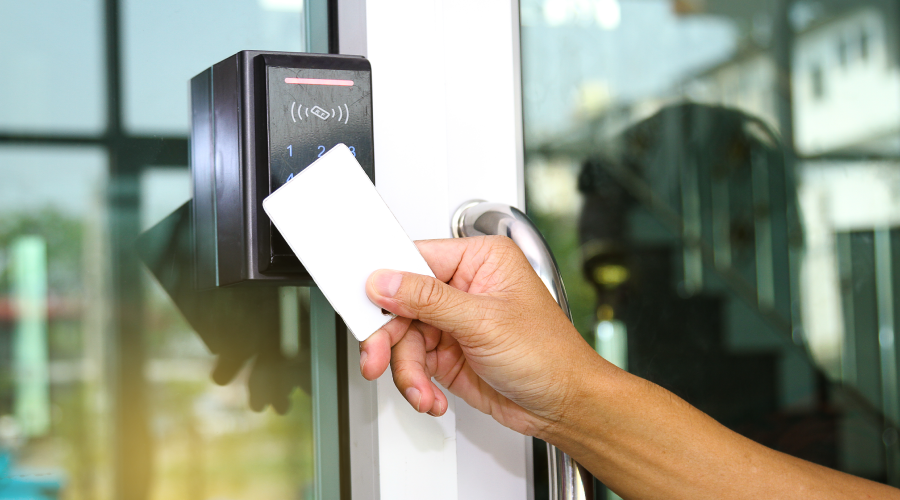Proper Maintenance of Locks, Hinges and Handles Helps Lower Costs
Institutional and commercial facilities rely on door hardware to provide safe entrance and exit, as well as accessibility and security. But as door hardware technology improves, the requirements for inspecting and maintaining doors and door hardware also are changing.
New-generation locks, hinges, handles, closers and operators, among other door-hardware components, are altering the requirements for inspections to ensure compliance with the National Fire Protection Agency (NFPA) and local codes. As a result, managers now face the challenges of updating workers’ activities related to door hardware to also provide efficiency and reliability.
Maintenance Considerations
Generally, the most common pieces of new-generation door hardware have proven to be an effective way for managers to hold the line on maintenance costs. They offer greater durability and reduced maintenance frequency.
Locks. The choices available for enhanced lock security continue to expand rapidly. For example, the new devices include biometric readers, keypads and keyed locks in one assembly, improving security and reducing installation cost and the number of components requiring maintenance.
New lithium-manganese dioxide battery packs — standard, as well as custom 3-, 6-, and 9-volt batteries — operate in a temperature range of minus-40 degrees to 140 degrees. They offer up to a seven-year performance life in certain applications, and they reduce maintenance by extending reliability and replacement intervals for several brands of card-reader door locks.
Hinges. Continuous geared hinges reduce wear by spreading load forces more evenly over the full height of the door, rather than concentrating them at the hinge, as with conventional hinges. Geared hinges also can: lengthen the door’s life; enhance reuse by allowing changes from left- to right-hand or the opposite; reduce sound transmission; and prevent distortion.
Technicians also can install these hinges on new doors or as upgrades, and they are available for 7-, 8-, and 10-foot wood or metal doors. They are specially suited for heavy-traffic or high-impact doors because they do not generate the maintenance requirements caused by loose hinges, sagging and misalignment. Since they have no hinge gap, they are more secure, cannot be pried open, and work with either manual or electric doors.
Nylon bearings support the vertical load, and a flexible shield fastened to the door and jamb covers the entire hinge to protect the gears and cover a pinch line.
Handles. Managers are specifying lever handles more often for commercial facilities. They tend to be easier to use and more durable, and they comply with accessibility guidelines better than knob handles. They exceed the highest standards for cycles without maintenance even for high-traffic applications.
Very seldom are door handles sanitized every day, let alone every use, but they are an obvious place for germs to spread due to the frequency of contact. An innovation in door handle care and maintenance catching on rapidly is the application of a permanent silver-ion treatment to the surface of the handles during manufacture.
Silver has well-known germicidal properties, as germs will not grow on its surface. Manufacturers bond the silver to a ceramic material, creating a slow-release capability. Moisture triggers an increase in the release to offer protection when the bacterial growth is the greatest. The innovation has proven effective against E.coli, legionella, listeria, and salmonella, and it has seen applications in schools and hospitals, among other types of facilities.
Closers. New closer technology offers year-round inspection-free and adjustment-free operation, provided technicians install the closers according to manufacturer instructions. They come with all-season hydraulic oil and are available in heavy-duty construction that exceeds ANSI Grade 1 specifications, so they are applicable for high-traffic areas.
Another maintenance-saving alternative is a versatile three-in-one hinge stopper-closer. It eliminates the need for separate closer hardware. This unit has hydraulically controlled motion built into the hinge pin, so upon pushing to close, the door swings at normal speed for 30 degrees, then slows until almost closed, and finally closes sharply against the jamb for complete closure.
Operators. Automatic door operators are programmed to allow access with a controlled cycle to protect users from injury and protect doors from damage, extending their performance lives.
One innovation in door operators is the cycle-counter system, which lets maintenance technicians know when the operator reaches a preset number of operating cycles. Since door wear and tear is proportional to the number of cycles, the technician can set the number of cycles to activate a signal. When the operator approaches that number of cycles, the visual signal appears, indicating it is the optimum time for maintenance, such as cleaning, checking for leaks, and tightening fasteners loosened because of vibration.
The most important maintenance for automatic swinging doors is the daily inspection. This brief check ensures: required signage is in place; nothing is impeding or slowing foot traffic or door operation; no trip hazards are present; and all the automatic functions and safety controls, such as finger guards and motion controls, are in place and work properly.
Since the amount of door use often varies depending on the weather, special events, and similar factors, it is not optimal to schedule preventive maintenance (PM) on a set timetable. Sometimes, the PM might not occur often enough to prevent a malfunction. In other instances, it might occur too often, resulting in unnecessary costs. Either way, it is a strain on labor and cost managers can prevent.
Related Topics:













